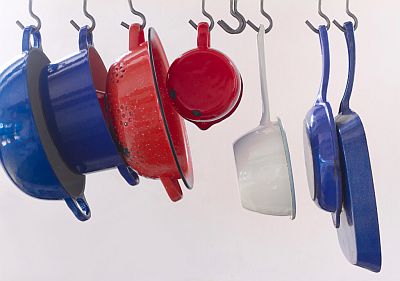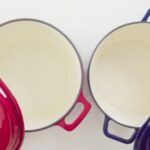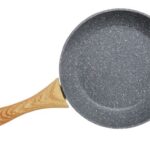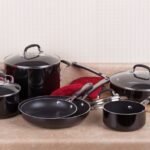While traditional cast iron cookware is an essential part of every kitchen, many chefs and cooks prefer the enameled version. Enamel-coated cast iron is much easier to clean and it doesn’t require seasoning. The inner coating has light non-stick properties and prevents iron from getting into your food. These cookware pieces are available in various bright colors to meet customers’ expectations and match existing colors in the kitchen design.
Is Enameled Cast Iron Cookware Safe for Cooking?
The use of non-coated cast iron cookware can result in iron raising to high levels. Excessive iron levels in the body can lead to serious health problems. Of course, this is not a problem with enameled cast iron. The main advantage of enameled pieces over traditional cast iron vessels is their inertness. The enamel coating is non-reactive, so you can cook all kinds of foods in an enamel pot without worrying about the leaching problem. However, once the enamel coating is damaged, the interior surface is no longer inert, and iron in the pot core can leach into the food.
According to the FDA’s Center for Food Safety and Applied Nutrition, enamel-coated iron cookware is considered safe. The manufacturers have discontinued using cadmium and lead pigments. Cookware lines imported from abroad must meet the FDA safety standards. The import of cookware whose glaze contains cadmium is prohibited.
Take precautions and avoid importing enameled cast iron vessels from abroad. Make sure you only buy high-quality products from trusted brands. The enamel coating must be thick and chip-resistant.
Advantages of Enamel Cast Irom Cookware
The following are the main advantages that enamel-coated cookware offers:
- Safety: Enameled cast iron cookware is healthy and safe to use. Unlike bare cast iron, these utensils won’t react with your food. As already mentioned, you can cook any kind of food in it, including tomatoes and other acidic foods.
- Easy to use: The enamel coating is partially non-stick, making cooking easy and there is little sticking to the bottom.
- Longevity: High-quality enameled cast iron cookware is extremely durable. The products last for many years and can be passed on from parents to children.
- Heat resistance: The enameled pans and pots can be heated to high temperatures (although not as high as pure cast iron), making them a popular choice for searing and braising foods.
- Even heat distribution: The cast iron construction conducts and retains heat well, ensuring an even and consistent temperature throughout the pot.
- Heat retention: Enamelled cast iron pans require only low to medium heat, making this cookware energy efficient. Excellent heat retention helps keep food warm when served.
- Versatility: Enamelled cast iron cookware is suitable for all heat sources and any type of stove. It is also suitable for storing leftover food in the fridge and can be used as a serving dish.
- Low maintenance: The enameled surface does not require seasoning and therefore requires very little maintenance. Enamel glaze also prevents rust. The cookware is available in a variety of colors for visual appeal.
Disadvantages of Enameled Cookware
- Larger enameled cast iron vessels can be quite heavy for general use. However, many cooks prefer heavier and sturdier dishes over thin pieces that easily warp or dent after use.
- Enameled cast iron has lower thermal conductivity compared to bare cast iron. It takes a little longer to reach the desired temperature. However, the heat remains evenly distributed throughout the pot, ensuring good cooking.
- The porcelain enamel coating is relatively fragile and may tend to chip off at some point. Cracks may also occur if you hit the pot too hard.
- Metal utensils can scratch or chip the coating. Instead of metal utensils, consider using wooden or silicone utensils.
- Another disadvantage is that high-quality enameled cast iron cookware can be very expensive. It typically costs more than an uncoated version, especially from well-known brands like Le Creuset and Staub.





Enamel Coated Cast Iron Cookware Set is very safe; it has many benefits like it’s enamel coated is non- reactive safe to use & non- stick flexible cookware set.
Cast iron cookware has been used for centuries. My thoughts, plain cast iron is far better than teflon coated cookware. With time and a bit of effort, I can get almost the same nonstick surface, –still working on that though.
Does enameled coated cast iron bottom scratch a glass topped range?
Cookware with enameled coated outside surface is less likely to leave metal markings on glass/ceramic range than uncoated cast iron, copper or aluminum. To prevent scratches, check the backside cookware surface for rough spots to make sure the bottom is smooth. Also avoid sliding pans across the glass when you need to move them.
Finally an article that got straight to the point!:) I wanted to know if porcelain enamel coating skillet will accept some of tomatoe sauce/topping i’ll be cooking. Yay, the one i ordered is on its way:) Thanks!
Have been trying to find out if Frigidaire enamelled light weight cast iron has any PTFE. PFES,PFOA, lead or cadmium. Nothing on the packaging and cannot find anything on line so called customer service and haven’t heard back from them. They are attractive and lightweight but are made in China so was just double-checking. Do you have any information on this brand?
Medium heat is best with enameled cast iron, NOT recommended for braising – high heat can damage interior finish
That doesn’t make any sense. Enameled cast iron is perfect for braising.
Enameled cast iron cookware is only good for the medium heat or lower heat. No higher than the medium heat. Otherwise, the coating will be damaged. I have read instructions about how to handle enameled cast iron cookware and they advised that the enameled cast iron cookware needs to be used from lower to medium heat only. Never on high heat.